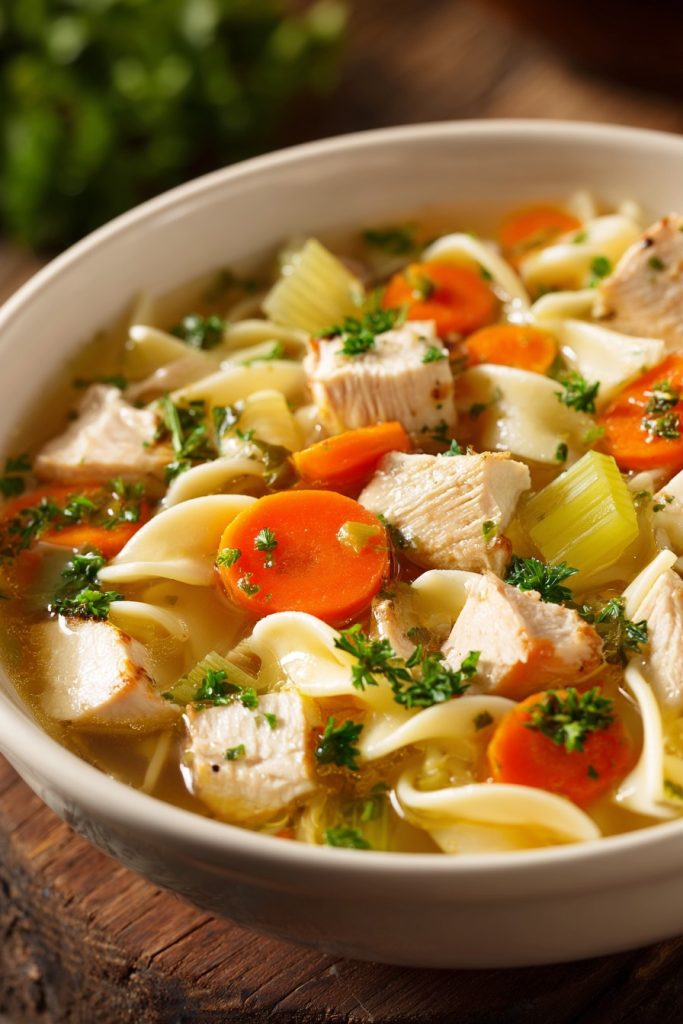Forget those sad, canned versions—this homemade Souplantation-style chicken noodle soup brings the beloved buffet favorite right to your kitchen! Fresh ingredients, rich broth, and that perfect noodle texture make this the ultimate comfort food.
Why This Recipe Works
- Using a combination of chicken thighs and breasts creates layers of flavor and texture—thighs for richness and breasts for tender bites.
- Simmering the broth with aromatics like celery, carrots, and onions for at least 30 minutes extracts maximum depth and savory notes.
- Adding egg noodles in the final 10 minutes of cooking ensures they stay perfectly al dente without turning mushy.
- A splash of lemon juice at the end brightens the entire dish, balancing the richness with a hint of acidity.
- Finishing with fresh parsley and dill adds a burst of herbal freshness that elevates the soup from good to unforgettable.
Ingredients
- 1.5 pounds boneless, skinless chicken thighs, cut into 1-inch pieces
- 1 pound boneless, skinless chicken breasts, cut into 1-inch pieces
- 2 tablespoons olive oil
- 1 large yellow onion, finely diced
- 3 celery stalks, sliced into 1/4-inch pieces
- 3 large carrots, peeled and sliced into 1/4-inch rounds
- 4 cloves garlic, minced
- 8 cups low-sodium chicken broth
- 2 bay leaves
- 1 teaspoon dried thyme
- 1 teaspoon black pepper
- 1 tablespoon salt (adjust to taste)
- 12 ounces wide egg noodles
- 2 tablespoons fresh lemon juice
- 1/4 cup fresh parsley, chopped
- 2 tablespoons fresh dill, chopped
Equipment Needed
- Large stockpot or Dutch oven (6-8 quart capacity)
- Wooden spoon or spatula
- Chef’s knife and cutting board
- Measuring cups and spoons
- Ladle for serving
Instructions

Step 1: Sauté the Aromatics
Heat 2 tablespoons of olive oil in your large stockpot over medium heat until shimmering—about 2 minutes. Add the finely diced yellow onion, sliced celery, and carrot rounds, stirring occasionally until the vegetables soften and the onions turn translucent, which should take approximately 8-10 minutes. You’ll know they’re ready when the carrots begin to brighten in color and the celery releases its fragrant aroma. Stir in the minced garlic and cook for another minute until fragrant but not browned. This foundational step builds the flavor base, so don’t rush it! The gentle sweating process allows the natural sugars in the vegetables to caramelize slightly, creating a sweeter, more complex broth.
Step 2: Brown the Chicken
Push the vegetables to the sides of the pot, creating a well in the center. Add the cubed chicken thighs and breasts in a single layer, letting them sear undisturbed for 3-4 minutes until a golden-brown crust forms on one side. Flip the pieces and cook for another 3 minutes—they don’t need to be cooked through completely since they’ll simmer later. You should hear a satisfying sizzle and see browned bits forming on the bottom of the pot; these fond bits are flavor gold! Avoid overcrowding the pot; if necessary, brown in two batches to prevent steaming. The Maillard reaction happening here adds incredible depth to your soup.
Step 3: Build the Broth
Pour in 8 cups of low-sodium chicken broth, using your wooden spoon to scrape up all those delicious browned bits from the bottom of the pot—this is where magic happens! Add 2 bay leaves, 1 teaspoon dried thyme, 1 teaspoon black pepper, and 1 tablespoon salt. Bring the mixture to a vigorous boil over high heat, then immediately reduce to a gentle simmer. Partially cover the pot and let it bubble away for 30 minutes, maintaining a temperature where small bubbles consistently break the surface but don’t roll violently. This slow simmer allows the chicken to become fork-tender and the flavors to meld beautifully.
Step 4: Cook the Noodles
After 30 minutes of simmering, add 12 ounces of wide egg noodles directly to the pot. Stir gently to submerge them in the broth, then cook uncovered for exactly 8-10 minutes, stirring occasionally to prevent sticking. The noodles are done when they’re tender but still have a slight bite—al dente perfection! Test one noodle at the 8-minute mark; it should offer gentle resistance without being crunchy. Remember, the noodles will continue to absorb liquid even after cooking, so we want them slightly underdone. The starch released from the noodles will naturally thicken your broth to that classic Souplantation consistency.
Step 5: Finish and Serve
Turn off the heat and remove the pot from the burner. Fish out and discard the bay leaves—they’ve done their job! Stir in 2 tablespoons of fresh lemon juice, which will brighten all the flavors miraculously. Let the soup rest for 5 minutes off heat; this allows the noodles to absorb more broth and the flavors to settle. Right before serving, stir in 1/4 cup chopped fresh parsley and 2 tablespoons fresh dill. Ladle into bowls while steaming hot, and watch as everyone’s faces light up with that first spoonful of comfort!
Tips and Tricks
For the most authentic Souplantation experience, consider making your broth from scratch using chicken bones—simmer 3-4 pounds of chicken wings or backs with your aromatics for 2-3 hours, then strain and proceed with the recipe. If you’re short on time, enhance store-bought broth by simmering with Parmesan rinds or a tablespoon of tomato paste for extra umami. To prevent noodles from becoming soggy in leftovers, cook them separately and add to individual bowls when serving, storing noodles and soup separately in the refrigerator. For a clearer broth, skim off any foam that rises during the first 10 minutes of simmering using a fine mesh skimmer or spoon. If you prefer darker chicken meat, use all thighs instead of the breast-thigh combination—they’ll remain juicier during the simmering process. To make this soup ahead, complete all steps except adding the noodles and herbs, then refrigerate for up to 2 days; reheat and add noodles fresh when ready to serve. For those who love extra vegetables, add 1 cup of frozen peas or corn during the last 5 minutes of cooking—they’ll bring color and sweetness. If your soup seems too thin after adding noodles, mix 1 tablespoon cornstarch with 2 tablespoons cold water and stir it in during the last minute of cooking to thicken slightly. Always taste and adjust seasoning right before serving, as noodles absorb salt—you might need an extra pinch or two. For a richer mouthfeel, stir in 2 tablespoons of butter at the very end off heat—it’ll add a luxurious gloss to the broth.
Recipe Variations
- Creamy Version: Transform your soup into a creamy delight by stirring in 1 cup of heavy cream or half-and-half during the last 5 minutes of cooking. Add a teaspoon of dried tarragon for a subtle anise flavor that pairs beautifully with the cream. This variation creates a richer, more indulgent soup that’s perfect for chilly evenings when you need extra comfort.
- Asian-Inspired Twist: Replace egg noodles with soba or udon noodles, and add 2 tablespoons of soy sauce and 1 teaspoon of grated ginger to the broth. Garnish with sliced green onions and a drizzle of sesame oil instead of parsley and dill. This variation brings an umami-packed, slightly spicy dimension that’s completely addictive while maintaining the comforting noodle soup essence.
- Vegetable-Packed Power Bowl: Make it meat-free by omitting chicken and using vegetable broth. Add 2 cups of chopped kale or spinach during the last 5 minutes, and include 1 cup of sliced mushrooms when sautéing aromatics. The result is a nutrient-dense, vegetarian-friendly version that doesn’t sacrifice flavor or heartiness—perfect for Meatless Mondays!
- Spicy Kick: For those who like heat, add 1-2 teaspoons of red pepper flakes when building the broth, or stir in a tablespoon of sriracha at the end. Garnish with sliced jalapeños and a squeeze of lime instead of lemon. This variation wakes up your taste buds while still delivering that classic chicken noodle comfort—ideal for clearing sinuses during cold season.
- Gluten-Free Adaptation: Simply swap regular egg noodles for your favorite gluten-free pasta—brown rice noodles or chickpea pasta work wonderfully. Ensure your chicken broth is certified gluten-free, and thicken with arrowroot powder instead of cornstarch if needed. This variation allows everyone to enjoy the soup without compromising texture or flavor.
Frequently Asked Questions
Can I use rotisserie chicken instead of raw chicken?
Absolutely! Using rotisserie chicken is a fantastic time-saver. Skip the chicken browning step and add 4 cups of shredded cooked chicken during the last 10 minutes of simmering—just long enough to heat through. This method prevents the chicken from becoming tough or stringy from overcooking. You’ll still get great flavor, though you might miss some depth from browning fresh chicken. Enhance the broth by sautéing the vegetables in the chicken drippings from the rotisserie container if available.
How long does this soup keep in the refrigerator?
Properly stored in an airtight container, your chicken noodle soup will stay fresh for 3-4 days in the refrigerator. The noodles will continue to absorb broth, so you may need to add a splash of water or broth when reheating. For best quality, consider storing noodles and soup separately if you know you’ll have leftovers. Always reheat gently on the stove over medium-low heat, stirring occasionally until steaming hot—about 165°F on a food thermometer.
Can I freeze this chicken noodle soup?
You can freeze the soup base (broth, chicken, and vegetables) for up to 3 months, but I don’t recommend freezing with noodles included—they become mushy and grainy upon thawing. Portion the soup without noodles into freezer-safe containers, leaving 1-inch headspace for expansion. When ready to serve, thaw overnight in the refrigerator, reheat on the stove, and cook fresh noodles directly in the hot soup for 8-10 minutes. This method preserves perfect texture every time!
What’s the best way to reheat leftovers?
The stovetop is definitely your best bet for reheating—microwaving can make noodles rubbery and heat unevenly. Place desired amount in a saucepan over medium-low heat, stirring occasionally until it reaches a gentle simmer. If the soup has thickened too much, add a quarter cup of water or broth to reach your preferred consistency. This usually takes 8-10 minutes for a single serving. Always ensure the soup reaches 165°F before serving for food safety.
Why did my noodles absorb all the broth overnight?
This is completely normal! Egg noodles are starch sponges that continue absorbing liquid even when refrigerated. It’s not a recipe flaw—it’s science! To fix it, simply add more warmed chicken broth or water when reheating until you reach your desired consistency. For future batches, you can slightly undercook the noodles or store them separately from the broth. Some people actually prefer the thicker, stew-like consistency that develops overnight!
Summary
This Souplantation-inspired chicken noodle soup delivers restaurant-quality flavor with homemade heart. Tender chicken, perfect noodles, and aromatic broth create ultimate comfort in every bowl.



